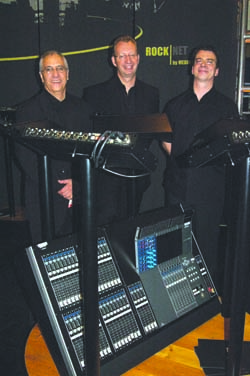Market Distribution

- MILLINGTON, NJ-Like many great ideas, Media Numerics was born of a friendly outdoor conversation over a couple of drinks and a few good cigars. Media Numerics' president and chief technology officer Matthias Knoth had an idea brewing in a desk drawer for several years before he discussed it in the backyard of Vinnie Macri, Media Numerics' managing director of sales and marketing. The two had a work history going back to their days at Stage Tech, a German television broadcast company, and then following through to the time they both spent at Riedel Communications. By the time they were hashing out Knoth's ideas for the RockNet product line, the two already had a lot of history to rely on for their forthcoming business.
From left, Media Numerics' Vinnie Macri, Arnd Janus, and Matthias Knoth at AES 2006 with the RockNet.
Knoth and Macri hit it off partly because of a similar musical background: while Knoth was a musician working with local touring bands and tinkering with mechanics in his garage in Germany, Macri was on tours throughout the U.S. and Europe doing system tech on monitors or backline work for bands like Led Zeppelin and Pink Floyd. The RockNet line was developed with people in those positions in mind, as a suite of integrated networking technology designed to provide cost-effective, enhanced audio and data distribution for live performances. "It was fun getting back into our roots," said Macri.
After the scotch and cigars, Knoth headed back to Germany and started the technical drawing and designing the chip sets. He ended up with, as Macri described, a rocket ship. The product matured and developed as the two communicated new ideas overseas-before Knoth came back to the States for the 2005 AES show in New York. Until then, the product that they had been discussing was a digital transport system that could support 800 audio channels over Cat-5. When they stepped onto the show floor, however, they realized that such a product, which would no doubt be quite expensive, would not be desirable by customers who would be buying them for pricey digital consoles. "There were some digital console manufacturers introducing new products," explained Macri. "Digital consoles, when they first came out, were six-figures. We said, well nobody's going to buy a really expensive digital transport system based on 800 channels when they're going to be hooking it up to an $18,000 digital console. We're going to miss the point here." They scaled back the technology and came out with the RockNet 300, which transports 160 channels that can be dropped to a maximum of 768 outputs in the bidirectional network without limitation, and which features redundancy that in a ring configuration, the network is self-healing for single connection failures. "Not to say that maybe in years to come there wouldn't be a RockNet 800 product that would be more extensive and have more features," he said.
Right now the product line is comprised of about seven products, with more to come. Production begins in February, but the boxes exist in demo form and they are involved with several beta partners. "We did a lot of market research and interviews with end-users," Macri said. "Because Matthias and I and the other guys within Media Numerics come out of the business, we've been involved for many years. It's exciting that after so long you build up great relationships that most of our competitors don't have. The whole point is to maintain those good relationships." The third piece of the Media Numerics puzzle is Arnd Janus, who came from Alcatel to be the newly-formed company's chief executive officer.
The company and its RockNet product line debuted at AES 2006 in San Francisco, CA, and the guys from Media Numerics quickly learned that there would be interest far beyond the live-sound touring market. "The interest was so vast," Macri said. "There were performance space/theater people from the live performance field coming by, people from casinos, lots of installed sound contractors, lots of sound companies. There were four major broadcasters that came by. There are just so many applications."
Currently, the beta testing includes a wide variety of markets, including television, live events, touring companies, and some installation consultants, and the general goal for Media Numerics is to get the product out to major companies first, and then follow through with smaller companies after the initial development. "The very top is the elite-it is great prestige, and great to get them the product, but it's a narrow market," explained Macri. "Rather than building it from the bottom-up, we're building it from the top-down. We did a lot of research and information gathering before this product came out, and the primary benefits of the product is that it can do any of the big stuff right away. Then, because it can handle the big stuff, it's easy to do the smaller projects. If you can take RockNet and put it into NASCAR, for instance, it's so much easier to take it and put it into a 100-seat church. It's not that it's less of a job, but their requirements are not as extensive. If you build it from the top-down, you're way ahead of the game."
A daily selection of the top stories for AV integrators, resellers and consultants. Sign up below.
